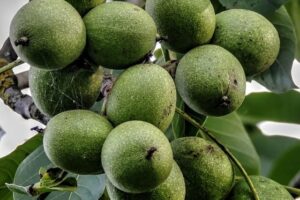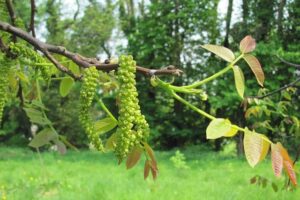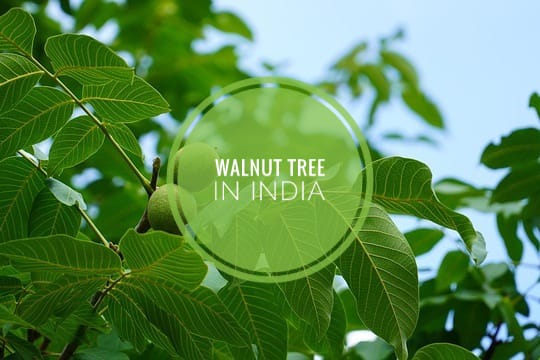Have you ever wondered why walnuts are prized as a “brain food” and also as a gift of prosperity? Maybe you’re here because you’re curious about growing a walnut tree (Akhrot) in India or you want to know its history, uses and benefits.
Either way, this guide will give you everything you need, from its origin to care tips, Growing Regions, problems, varieties, and surprising facts.

WALNUT TREE INDIA
The walnut tree is one of the most valuable trees you can grow in India. It is not only admired for its nuts but also for its medicinal, ornamental and cultural significance.
Here’s a quick descriptive overview of the walnut tree in India:
| Feature | Description |
|---|---|
| Common Name | Walnut Tree |
| Botanical Name | Juglans regia |
| Family | Juglandaceae |
| Native Region | Central Asia, Himalayas |
| Lifespan | 100 to 250 years |
| Tree Height | 10 to 40 meters |
| Fruit Type | Nut enclosed in a hard shell |
| Climate Preference | Temperate to cool climates |
| Flowering Season | Spring (March–April in India) |
| Nut Harvesting Time | September–October |
HISTORY/ORIGIN
The walnut tree has a long and rich history. Its scientific name, Juglans regia, comes from Latin. “Juglans” means “nut of Jupiter” while “regia” means “royal.” This shows the high regard people had for this tree in ancient times.
Walnuts are native to Central Asia and the Himalayan regions. From there, trade and migration helped spread them to Persia, Europe, and eventually worldwide.

In India, walnuts are primarily grown in Jammu and Kashmir, Himachal Pradesh and Uttarakhand. They have cultural value too, often used in local festivals, marriages and as offerings.
The nut is linked to prosperity and fertility, while the wood has long been used in fine carpentry.
GROWING CONDITIONS
Growing a walnut tree in India requires specific conditions. Let’s break them down:
- Soil: The tree thrives in deep, fertile, well-drained loamy soil. Avoid waterlogged or sandy soils.
- Water: Regular watering is essential during early growth. Mature trees need less water but benefit from deep irrigation in summer.
- Sunlight: Walnuts love full sun. At least 6 to 8 hours of direct sunlight daily is required.
- Temperature: Best growth occurs between 10°C to 25°C. They need chilling in winter for proper fruiting, which is why they grow in temperate Indian states.

KEY GROWING REGIONS
Walnut trees need a temperate climate with cold winters for chilling and moderate summers for fruit development. In India, cultivation is concentrated in a few states where such conditions naturally occur.
- Jammu and Kashmir – The undisputed leader in walnut production. The Kashmir Valley is world-famous for its high-quality thin-shelled walnuts with rich taste. Orchards here often grow naturally, and walnuts are an important part of local trade and culture.
- Himachal Pradesh – This state supports walnut cultivation in hilly districts such as Kinnaur, Kullu, and Chamba. The cool climate of these regions helps produce healthy trees and good-quality nuts. Farmers here are increasingly adopting grafted varieties to improve yields.
- Uttarakhand – Known for its mountainous landscapes, districts like Pithoragarh, Nainital, and Almora are key walnut belts. The nuts here are smaller compared to Kashmiri walnuts but are valued for their distinct flavor and organic nature.
- Arunachal Pradesh – A rising walnut-growing region in northeast India. The state has favorable soil and climatic conditions, making it a promising hub for future walnut farming. Government and farmers are both working to increase its cultivation here.
VARIETY OF WALNUTS
There are several varieties of walnuts in India. Each type differs in nut size, shell thickness, and kernel quality. Here are the major ones:
- Kagzi Walnut – Known for its thin shell, easy to crack, and sweet kernel.
- Placentia Walnut – Medium-sized nut with high oil content, popular for commercial farming.
- Lake English Walnut – Heavy yielding, large nuts, widely grown in Kashmir.
- Chandler Walnut – A high-yielding, internationally popular variety also grown in Himachal.
- Franquette Walnut – Late flowering, suitable for cooler climates, helps avoid frost damage.
CARE TIPS
Walnut trees may seem tough, but they need regular care to stay healthy.
- Pruning: Prune during dormancy in late winter. Remove dead or crossing branches. This improves airflow and nut production.
- Repotting: For young saplings in pots, shift them to bigger containers or plant in open soil when roots fill the pot.
- Fertilizing: Apply farmyard manure or compost once a year. Add nitrogen-rich fertilizer during the growing season.
- Propagation: Walnuts are usually grown from seeds or grafting. Grafted saplings give better nut quality and faster fruiting.
- Mulching: Spread organic mulch around the base to keep roots cool and conserve water.

COMMON PROBLEMS AND SOLUTIONS
Like all plants, walnut trees face pests and diseases. Here are some common issues and fixes:
- Aphids: These tiny insects suck sap from leaves. Use neem oil spray or insecticidal soap.
- Walnut Blight: A bacterial disease causing black spots on nuts and leaves. Prevent with copper-based sprays.
- Root Rot: Caused by waterlogging. Ensure proper drainage and avoid overwatering.
- Caterpillars: They feed on foliage. Handpick or use biological sprays like Bacillus thuringiensis.
- Frost Damage: Protect young trees with covers or shelter belts in extreme winters.
USES AND BENEFITS
Walnut trees are valuable not just for nuts but in many ways:
- Nutritional Value – Walnuts are rich in omega-3 fatty acids, protein, and antioxidants, making them excellent for brain and heart health.
- Medicinal Uses – Walnut oil is used in traditional remedies for skin health, digestion, and overall immunity.
- Wood Value – The timber is strong and attractive, used in furniture, carvings, and musical instruments.
- Environmental Role – Walnut trees provide shade, prevent soil erosion, and support biodiversity in orchards.
- Cultural Importance – In Kashmir, walnuts are part of marriage rituals and festive celebrations.
INTERESTING FACTS
Here are five surprising facts about walnut trees:
- Walnuts are one of the oldest tree foods known to humans, dating back more than 7000 years.
- The shape of the walnut kernel resembles the human brain, which is why it’s called “brain food.”
- Walnut trees can live for more than 200 years, continuing to produce nuts for generations.
- The husk of walnuts was traditionally used to make natural hair dye.
- Walnut shells are used in polishing, cleaning, and even in cosmetics as scrubbing agents.

FAQs
FREQUENTLY ASKED QUESTIONS ABOUT WALNUT TREE IN INDIA
Q1. Can we grow walnut trees in all parts of India?
Walnuts require a temperate climate with cold winters and mild summers. They grow best in states like Jammu, Kashmir, Himachal Pradesh, and Uttarakhand.
Q2. How long does it take for a walnut tree to bear fruit?
Seed-grown walnut trees may take 8 to 10 years to produce nuts, while grafted saplings can start bearing within 4 to 5 years.
Q3. Do walnut trees need special soil?
Yes, they prefer deep loamy soil with good drainage. Avoid sandy or waterlogged soils because they lead to root diseases and poor nut development.
Q4. How many walnuts can one tree produce?
A mature walnut tree can produce between 30 to 80 kg of nuts each year depending on variety, soil fertility, and growing conditions.
Q5. Are walnuts from India different from imported ones?
Indian walnuts are known for their thin shells and sweet taste. Imported ones may be larger but Indian walnuts are considered more flavorful and natural.
CONCLUSION
The walnut tree in India is not only a source of delicious and nutritious nuts but also a tree of heritage and culture.
With the right care, it can thrive for decades and reward us with shade, timber, and valuable nuts. Whether you’re a home gardener or planning an orchard, planting a walnut tree is a gift for future generations.
Thanks for reading. Keep growing, keep exploring, and don’t forget to return here at gardeningbud.com for more plants, tips and gardening wisdom.
